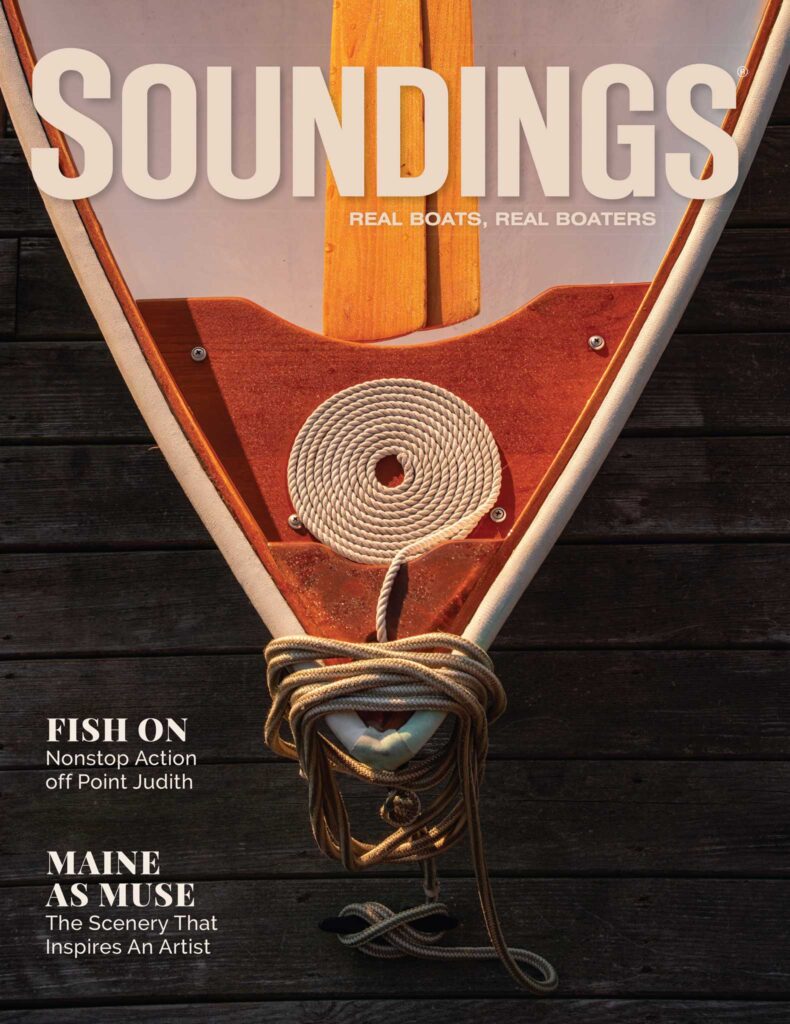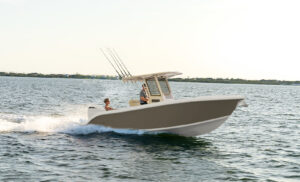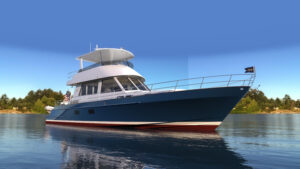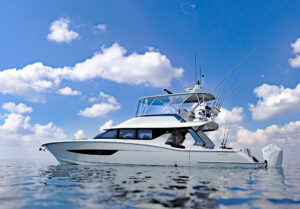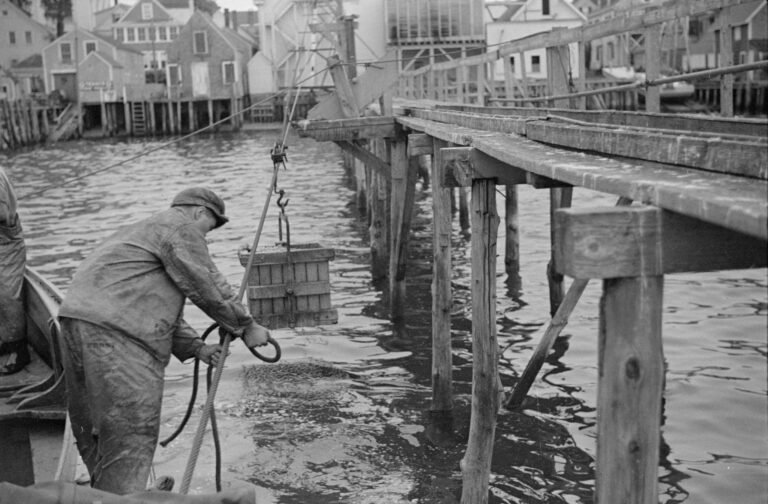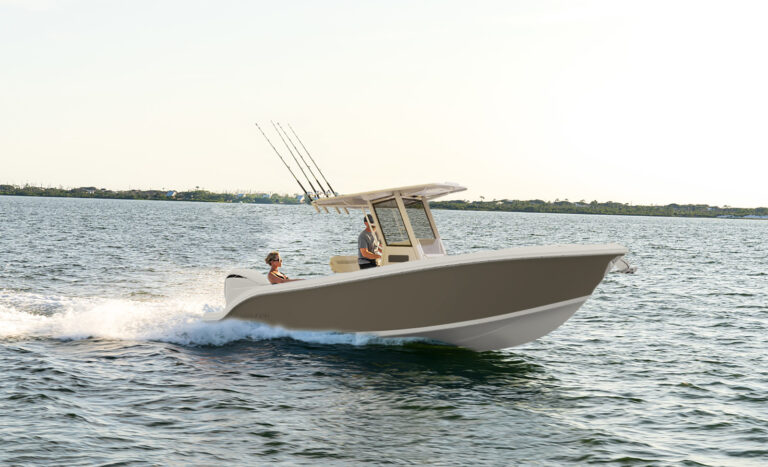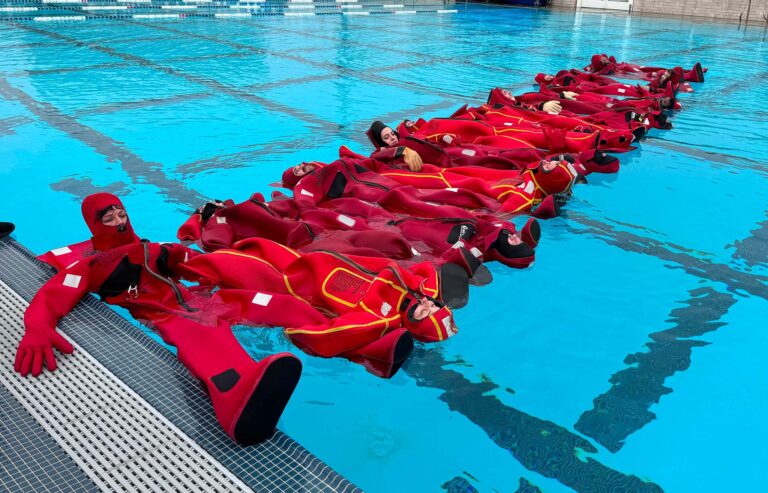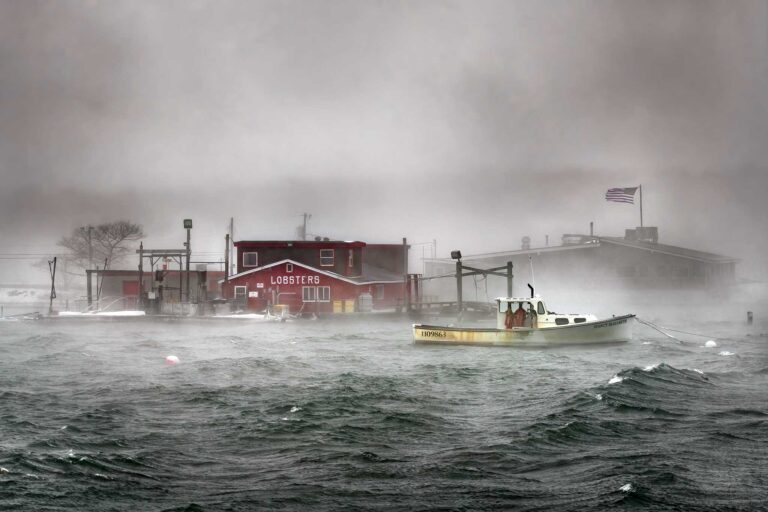Rhode Island. Little Rhody. The Ocean State. It’s small, but when it comes to boats, the place feels big. Not as big as in the glory days, before the “real” America’s Cup left Newport and before the recent economic turbulence. Still, the marine trades are “among the only growing sectors in manufacturing and blue-collar work,” according to Lisa DiRaimo, executive director at the Rhode Island Marine Trades Association. “And despite the recession, the industry has held its own.”

Paul Harden, at the Rhode Island Economic Development Corp., estimates that marine trades still make up 2 to 3 percent of the state’s work force. Clearly, it’s a source of pride here that’s on display for everyone who gets off a plane at T.F. Green Airport in Providence, downstairs at the baggage claim on the way to the shuttle bus or the rental car pickup.
There are several boats on exhibit, three of them from the Herreshoff Museum in Bristol, R.I., including one that goes beyond just being a pretty wooden sailboat (www.herreshoff.org). Her name is Firefly, designed and built by Nathanael Greene Herreshoff, aka the Wizard of Bristol, the patron saint of U.S. yacht designers. It’s a Watch Hill Herreshoff, which sometimes is referred to as the 880 Class because the first hull was assigned that number by Herreshoff.
What the traveler sees there by the baggage carousel is, indeed, the first Watch Hill, the prototype, the mother ship. Measuring 24 feet, 6 inches overall, she was launched in 1922 as Josephine for one F.S. Jenckes, who was part of a group of 11 gentlemen from the Watch Hill (R.I.) Yacht Club, a venerable institution that’s turning 100 next year and begins to commemorate — and celebrate — the occasion this summer (www.whyc.net). This group of sailors sought to establish a racing class that was fit for their home waters of Little Narragansett Bay and the rougher, more current-prone Fishers Island Sound.
“They went up to Bristol to see Capt. Nat,” says Dick Holliday, a former commodore of the Watch Hill Yacht Club and a long-timer in this class. Herreshoff listened to their request and, in his mind, went over the options that presented themselves. The venue was rather shallow and varied from fairly flat waters to choppy conditions with some swift currents running at Fishers Island, so the boat had to be versatile, good in light air and manageable in a fresh breeze.
Nat went back in his files to 1898, when he had designed a boat for a similar purpose, the Buzzards Bay 15, which had a comely spoon bow and was raced at the Beverly Yacht Club in Massachusetts. Then there was a cousin of that boat, the Newport 15, which was quite similar, so he could offer the Watch Hill folks a pretty good idea of what he had in mind. Herreshoff replaced the gaff with a Marconi rig, raised the sheer slightly aft, and changed the cockpit coaming and deck hardware arrangements.
As a vertically integrated boatyard, where everything was produced on site, the Herreshoff Manufacturing Company delivered quickly. It took about four months from receiving the commission in August 1922 to the launch of Josephine, which later became Firefly, the boat at the airport. After the sea trials, “some minor changes” had to be made, Holliday says, like chopping a “couple of feet off the top of the mast.” Ten more orders were placed, and in the spring of 1923, Herreshoff delivered the fleet of 11 boats by tug from Bristol to Watch Hill, ready to roll into their first racing season — and many more thereafter.
For the next four decades, these little yachts with a 15-foot waterline length were the mainstay of the club’s adult racing program. And, miraculously, at least seven of the original 11 still exist. “Two were wrecked in the hurricane of 1938, but the usable parts were combined to rebuild one afterward,” says Holliday.
From wood to “frozen snot”
In the 1960s, the clock was ticking on these Watch Hill Herreshoffs because they became difficult and expensive to maintain and campaign. Other boats appeared on the scene, but none quite struck a chord with the club’s sailors like the Watch Hill. If 1967 was the Summer of Love in San Francisco, 1968 was the year of the Watch Hill Herreshoff’s rebirth.
A group of “barflies,” as Holliday calls them, got together and decided to make them out of plastic — “frozen snot” as L. Francis Herreshoff once sneered. This group included Avard E. Fuller, the heir to the Fuller brush company, who financed the building of seven of the early boats; Hubbard Phelps; John F. Hall Jr., owner of the Frank Hall Boat Yard in neighboring Avondale; and David Pugh, who donated his boat, which had sail No. 3, as the plug for the mold. The boat was named Moveable Feast, but it was hull No. 880, so Josephine became the mother ship again — 47 years after her launch — passing down her hull shape to the future generation of fiberglass boats, which henceforth were called the Watch Hill 15.
Allan Vaitses, of Mattapoisset, Mass., molded the first boats, which were finished and delivered by Hall’s yard, starting in August 1969. They came out nice, but R&D continued a little after launch with the help of local sailmaker Sandy van Zandt. The new aluminum rig that had a loose-footed jib and a fixed backstay was moved aft, inside the cockpit coaming. And people liked what they saw. “We thought we’d build five or six boats, tops, but until the mid-1990s, we ended up building 25 of them,” Hall says. “It sure revitalized the fleet, and the boat remains the signature class of the Watch Hill Yacht Club.” A few boats were sold out of the area, but all of them, save for one on Chesapeake Bay, returned to Watch Hill.
Today, the fleet still sees a turnout of a dozen boats or so and keeps an active racing schedule with spring, summer and fall series, several holiday races and regular Wednesday and Saturday dates. These races also offer a social component to members who come to greet the finishers at the clubhouse. Wednesday traditionally is a casual non-spinnaker date, so the crews are smaller. The weekends bring out the chutes, which require an extra set of hands or two, especially in a breeze.
While an elegant boat from 1922 doesn’t pack the adrenaline of modern skiffs or multihulls, the club taps youth sailors to crew on the WH-15, where raw boat speed is less of a factor than smart sailing and solid tactics. “As they mature, they learn that sitting on a pretty boat beats beating themselves to pieces on the hot-shot classes,” says Hall.
Restoring the prototype
“The new boats, with their taller aluminum masts, have modern sails and are faster upwind, especially in light air, while the woodies can hold their own downwind under certain circumstances,” says Andrew Giblin, of MP&G, a Mystic, Conn., yard that specializes in wooden boat restoration and building. “These boats are light enough with a flat run aft that they can surf in the right conditions.”

Giblin used to own one and is proud of the commission to restore No. 880, which sported yellow paint when she was owned by brothers Herman and Charlton Muenchinger, fixtures at Watch Hill YC. After Herman’s passing on his 80th birthday in 1993, the family donated the boat to the Herreshoff Museum, so she returned to the place where she was launched more than seven decades earlier.
Sponsored by James “Ding” Schoonmaker, the 1975 world champion in the Olympic Star Class and a summertime resident of Watch Hill, she underwent an extensive refit at MP&G, where frames, the deck, centerboard and some planks were replaced. “We made hull molds using Herreshoff’s original offset tables from the MIT Hart Nautical Collection,” Giblin says. “We managed to save most of the planking from Port Orford cedar and her backbone but had to manipulate the rocker by bending the keel to get her sheer back.”
So the class that carried so much of the racing tradition in the first 99 years of the Watch Hill Yacht Club is ready to continue into the second century. Next time you fly into Providence and wait for your bags, check out No. 880, the boat that started it all — not once but twice. Maybe you’ll remember her story and that of the people who conceived her, built her and kept her alive for 90 years. It is as good a tale as any to explain why the Watch Hill class still is relevant, why the club still is happy, why the name Herreshoff still lives and why folks in the Ocean State still like to brag about their boats and how they build them.
Dieter Loibner is sailing editor for Soundings.
This article originally appeared in the July 2012 issue.

